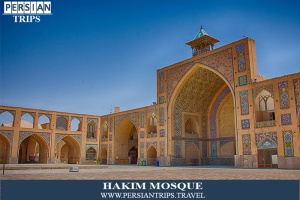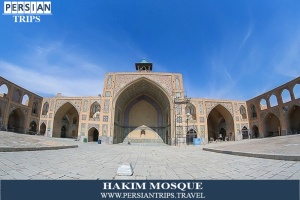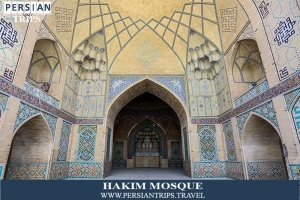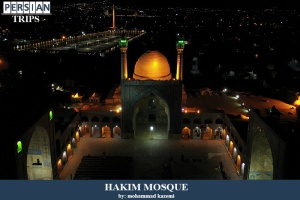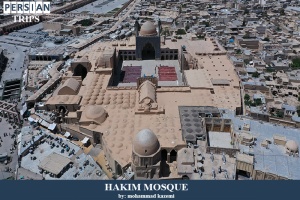Hakim Mosque
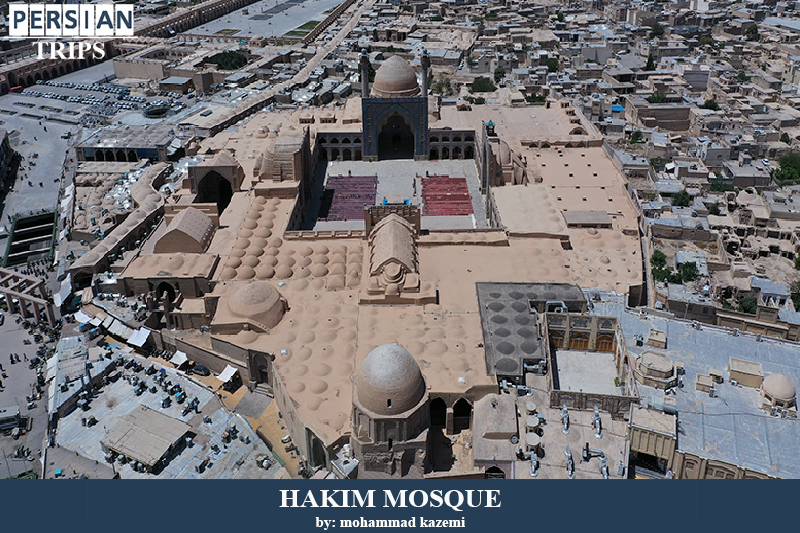
Isfahan Hakim Mosque was built in 1688 during the reign of Shah Abbas II Safavid in the old quarter of Isfahan known as Bab al-Dasht, where the remains of a mosque from the beginning of Islam called Rangarzan or Jorjir Mosque exsted.
The founder of the mosque was a person known as Taqrab Khan, one of the physicians of Shah Abbas II and Shah Safi, who was disliked by the Safavid court and fled to India. Mohammad Davood, nicknamed Taqrab Khan, found a privileged position in India and collected a lot of property and sent part of his property to Isfahan, and this mosque, which later became known as Hakim, was built by his relatives. The mosque is built with the usual plan of four porches mosque and, like the religious buildings of the Safavid period, has beautiful decorations. According to the inscriptions of this mosque, prominent and famous architects, craftsmen and calligraphers such as Bana Mohammad Ali bin Ustad Alibek Bana Esfahani, Mohammad Reza Emami, Mirza Mohammad Kashipez and Mohammad Baqer Shirazi have played a role in the construction of this mosque, all of whom are the most prominent masters of the time. Hakim Mosque of Isfahan has many endowments in the past, some of which have been Hakim Mosque of Isfahan has many devotions in the past, some of which have been destroyed and the rest includes a number of shops around the mosque and shops in Isfahan markets. This historical monument was registered in the list of national monuments of Iran in 1934 with the number 223.
Architecture of Hakim Mosque in Isfahan
The architecture of Isfahan Hakim Mosque and its beautiful decorations, although a weaker example compared to Sheikh Lotfollah and Imam Mosques, is still among the outstanding works of the Safavid period and shows the style of four-porch architecture in a magnificent way. Hakim Mosque with irregular plans is about eight thousand square meters and like many buildings of the Safavid period is made of brick. The interesting point in the architecture of Hakim Mosque is that this mosque has no minaret and only has a large and prominent dome. Hakim Mosque has a courtyard with approximate dimensions of 61 meters × 53 meters with a porch on each side. The roofed nave of the mosque is an example of large and interesting naves of mosques in Isfahan province and is square in shape with three entrances on the east, south and west sides. On the northeast side of the mosque, there are basins that are surrounded by arches. Part of the light in this space is provided by regular hexagonal grids above the walls. The floor of the arches is about fifty centimeters higher than the floor of the pool house so that you can sit on it during ablution. On the southwest side of the mosque, there is a tomb known as Sadat Tomb. The tomb of Mohammad Ibrahim Kalbasi, the famous jurist of the thirteenth century, is also built in front of the eastern door, which is decorated with Mogharnas plastering.
Decorations of Hakim Mosque in Isfahan
The decorations of Isfahan Hakim Mosque, like other historical mosques of Isfahan in the Safavid period, are very impressive and exquisite. Each of the porches of the mosque is unique in its type of decoration and tiling, and the corridors of each of them have decorations of masonry and tiling. The general decorations of the porches consist of various forms of decoration, simple Moqelli knots with turquoise tiles, lilies, bergamots, suns, seven-color tiles in the role of New Moqelli flowers, etc. The south porch is one of the most beautiful porches of Hakim Mosque and a set of mentioned trinities can be seen in it. The roofed nave of the mosque is also decorated with beautiful tiles of seven colors with flowers and plants, turquoise tiles with drums, Islamic motifs with Moqeli tiles, etc. The decorations inside the dome of the mosque are of the simple Moqeli type, a combination of bricks and tiles and inscriptions in thuluth script.Hakim Mosque has three altars and its main altar, which is located just below the dome, has beautiful Mogharnas decorations and engravings of verses from Surah Esra. The other two altars of the mosque, which are located in the eastern and western naves, are decorated with inscriptions of verses from Surah Ma'idah and Salawat. Another feature of this mosque is two sunshine clocks, one on the northwest side of the mosque and the other on the top of the northwest porch. The pulpit of Hakim Mosque with its 200 years old is one of the interesting parts of this building.
Inscriptions of Hakim Mosque in Isfahan
The inscriptions of the Hakim Mosque of Isfahan, in terms of aesthetics as well as their famous calligraphers, are among the famous and important inscriptions in historical buildings. One of them is the historical inscription on the entrance of the mosque, which is written in thuluth script on an azure background by the famous calligrapher Mohammad Reza Emami. This inscription indicates the year of completion of the construction of the mosque, ie the year 1695, the name of the founder of the building, namely Hakim Mohammad Davood known as Taqrab Khan and the name of the calligrapher. The altar of the mosque, in addition to being decorated with a very beautiful work of Mogharnas, has several inscriptions. The inscription around the mosque is in thulith script on the bricks of azure tiles by Mohammad Reza Emami, which includes the sixth verse of Asra Surah.This inscription has a date of 1641. The inscription inside the altar by Mohammad Reza Emami includes verse 144 of Surah Al-Baqarah, which was completed in 1661. In general, in Hakim Mosque, there are several inscriptions in the handwriting of Mohammad Reza Emami, including Surahs Jumu'ah, Asri, Baqarah, Ma'idah, Dahr, Ikhlas, Takwir, etc. in the style of thuluth script and Nasta'liq, and Moqali lines or masonry in different parts of the mosque, such as inside the dome of porches. On the north side of the mosque, the name of the builder and architect of the mosque, Mohammad Ali Ibn Ustad Ali Beyk, the Isfahani building, can be seen in Nastaliq script and in white on an azure background.
To visit this historical site and other attractions of Isfahan province, you can join Persian trips Tourism group and experience an unforgettable trip.
Tags: Isfahan Province, Isfahan Attractions, historical attractions of Iran, Mosques in Iran











